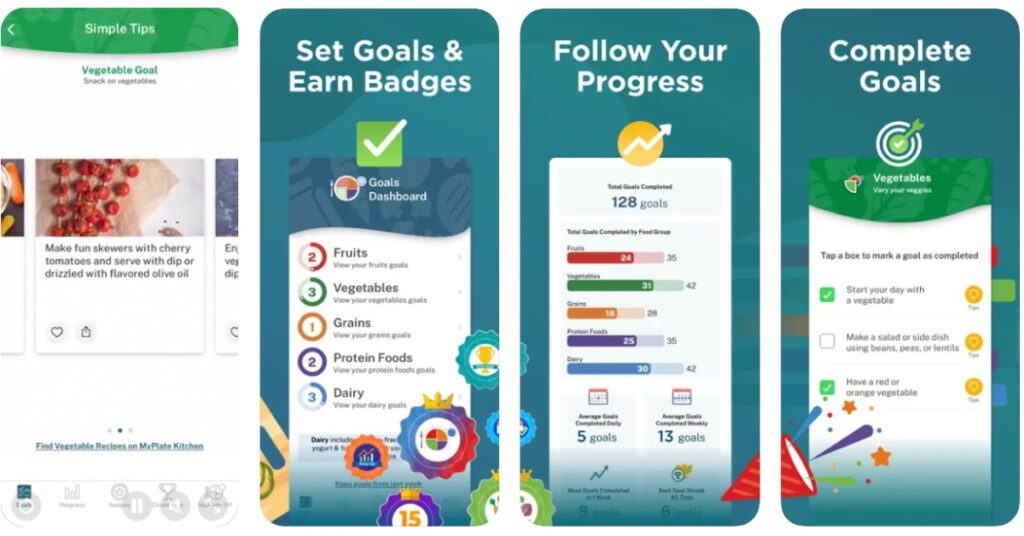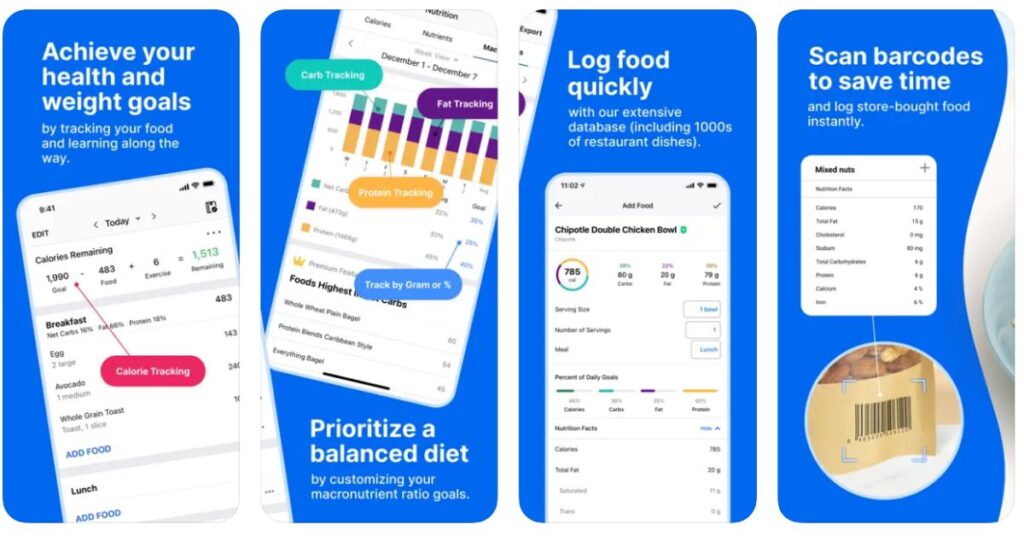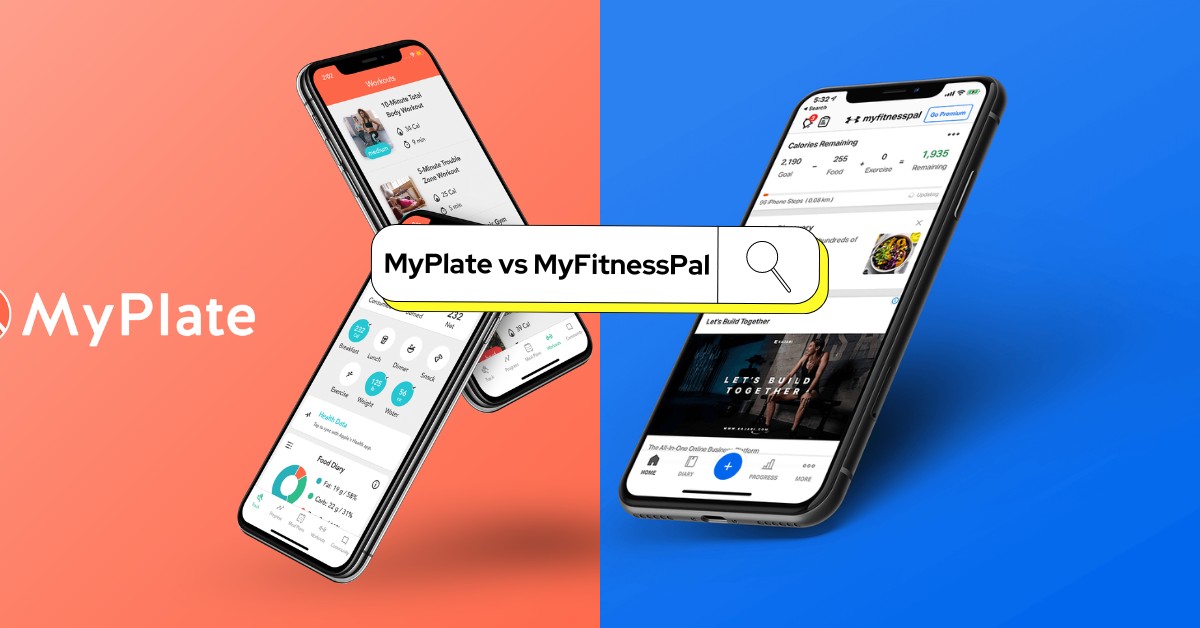Navigating the world of nutritional tracking can be overwhelming, but popular tools like MyPlate and MyFitnessPal can help you with that.
Thus, understanding the strengths and weaknesses of these tools can help you choose the perfect fit for your needs.
If you want to know about these tools, we’ve given a detailed head-to-head MyPlate vs MyFitnessPal comparison to help you choose the perfect platform for your requirements.
MyPlate vs MyFitnessPal: Overview
Understanding MyPlate
Want to set personalized goals for healthy eating? With MyPlate, you can accomplish that! MyPlate is an excellent resource for understanding healthy eating guidelines.
By replacing the older food pyramid, a new current visual guide is developed from the United States Department of Agriculture to help you make healthy food choices.
It’s a colorful plate divided into five food groups – fruits, protein foods, vegetables, dairy, and grains, thus providing comprehensive information about the food you take.

Exploring MyFitnessPal
Reach your fitness goals with MyFitnessPal – your all-in-one companion for setting goals, tracking food, and monitoring progress.
Dive deep into the world of nutrition with detailed breakdowns of macronutrients, micronutrients, and calories for each food you log.
Not only just food, but it also goes beyond that. It tracks your water intake, sleep duration, steps walked, and even weightlifting progress, thus giving you a holistic view of your health and fitness.

Head-to-Head Comparison
Food Tracking
MyPlate: It can make a great starting point if you are a beginner seeking simple portion control guidance and a balanced diet focus.
It divides your plate into sections for fruits, grains, proteins, vegetables, and dairy, emphasizing healthy choices within each.
However, it takes detailed calorie and nutrient information, and doesn’t track specific food choices or progress over time.
MyFitnessPal: Unlike MyPlate, MyFitnessPal tracks individual food items, giving precise macronutrient, calorie, and micronutrient breakdowns.
It also offers a vast database of food, custom entries, barcode scanning, and goal setting for weight, macros, and other health metrics.
However, since it requires more effort to input and analyze data, it is suitable for those seeking data-driven insights and certain goal tracking.
Calorie and Macro Tracking
MyPlate: Unlike MyFitnessPal, it’s more of an educational tool emphasizing balanced meals and portion control. It Is often used more broadly for general nutritional education.
Its calorie and macro tracking are non-existent and only provide general portion sizes for different food groups.
MyFitnessPal: MyFitnessPal is more precise in tracking calories and macronutrients. It lets users input certain quantities and offers a detailed breakdown of nutritional information, including calories, carbs, proteins, and fat per serving.
Exercise Logging
MyPlate: Has a comprehensive database of exercises that comprises various workouts, activities, and sports. You can easily search for specific exercises and log their duration and intensity.
However, there is no built-in exercise logging feature, lacks detailed exercise tracking, and doesn’t calculate calorie burn, thus making it not suitable for personalized fitness goals.
MyFitnessPal: Unlike MyPlate, MyFitnessPal has an extensive database, covering a wide range of activities and letting you log various types of workouts and physical activities.
So, if you want detailed exercise tracking and want to focus more on weight management, it offers powerful features for granular exercise tracking, macro and micronutrient breakdown, exercise logging, and goal setting.
Goal Setting and Motivation
MyPlate: MyPlate offers general, non-qualifying goals like ‘Choose whole grains over refined grains’ or ‘Eat more fruits and vegetables.’ It can be useful for establishing healthier habits but lacks specificity for advanced users.
However, it has only limited tracking features as you can only monitor portion sizes visually based on MyPlate guidelines.
When it comes to motivational elements, it lacks active community engagement or challenges and only offers quizzes and games for learning.
MyFitnessPal: Allows setting personalized goals for calorie intake, weight, macronutrient distribution, and specific exercises, thus providing flexibility for different goals and progress levels.
It offers comprehensive progress tracking through charts and graphs for visualizing progress. So, get daily and weekly summaries showing exercise sessions and weight changes.
Further, it has built-in social features and challenges for enhanced motivation. So, connect with friends for mutual support, participate in community forums, and join challenges to compete and stay engaged.
Ease of Use
MyPlate: The user interface is simple and intuitive, relying on visuals and clear guidelines. Navigation is straightforward and intuitive, making it easy to find what you need.
It is good for those who prefer simplicity and visual cues, beginners seeking basic dietary guidance, and those needing a low-effort tool.
MyFitnessPal: Has a Steeper learning curve, especially for those unfamiliar with exercise logging and calorie tracking.
It is the right choice for those who want detailed tracking and customization and those individuals with fitness goals and data analysis needs.
Though it’s a powerful tool for detailed tracking and analysis, it requires investment in initial learning and exploration. Also, since it has more features and options, it can feel overwhelming at first.
Integration With Wearable Devices
MyPlate: It integrates with various wearable devices, letting you sync your data seamlessly. In this way, it ensures that exercise information is automatically updated in the app.
MyFitnessPal: Similarly, it also supports integration with popular wearable devices, thus making it convenient for those who use fitness trackers or smartwatches to monitor their physical activity.s
Premium Subscriptions
MyPlate
Though it is free to use, there’s also an option to ‘Go Gold’ for a fee which costs $9.99 a month, $29.99 for 6 months, and $44.99 a year.
MyFitnessPal
You can easily sign up for a free account and start tracking your food, macros, vitamins, and other micronutrients to see how everything you consume supports your goals.
However, if you want to level up your goals and access advanced features like barcode scans, custom macro goals, and intermittent fasting, you can upgrade to MyFitnessPal Premium for $79.99 a year or $19.99 a month.
Before that, you can also start a one-month free trial. Once the trial ends, your subscription will auto-renew unless you cancel.
MyFitnessPal Free vs Premium: Which One Is Beneficial? [2024]
Additional Features
MyPlate
- Offers a meal planner with customizable options like filtering by dietary needs and preferences, creating grocery lists, and suggesting recipes.
- Children’s section provides age-specific tips and resources for parents to encourage healthy eating habits in their children.
- Its partnership with USDA FoodData Central gives access to comprehensive and accurate food nutrient data.
- Interactive quizzes and games help you learn about healthy food choices in a fun and engaging way.
MyFitnessPal
- Seamlessly connect with friends and family to share progress, goals, and recipes, thus providing accountability and motivation.
- Advanced tools like macros and micronutrient tracking, workout routines and customized meal plans.
- Import recipes for online sources or create your own with built-in calorie and nutrient calculations.
- Quickly scan food labels to add items to your diary.
- Ask questions, get advice, and participate in discussions with other users.
MyPlate vs MyFitnessPal: Deciding the Right Tool For You!
MyPlate is often used as an educational tool to promote healthy eating habits and portion awareness. On the other hand, MyFitnessPal is popular among those who are specifically interested in precise calorie and macronutrient tracking for various purposes.
So, ultimately the choice between MyPlate and MyFitnessPal depends on your goals and preferences. The key to success lies in making sustainable lifestyle changes and adopting healthy habits.
However, note that both MyPlate and MyFitnessPal are just tools and MyPlate is no longer available for download on Android and iOS stores.
Thus, the best approach is often a combination of both. So, explore both apps, set your goals, track your progress, and take control of your health and fitness journey with MyPlate and MyFitnessPal.
MyFitnessPal vs Cronometer: Which Is Better? [2024] Yazio vs MyFitnessPal: Which Is Better Fitness App? [2024] FatSecret vs MyFitnessPal: Which Is Better? [2024] MyFitnessPal vs Fitbit: Complete Comaprison [2024]
FAQs
Which food tracking app is best?
It depends on your health and fitness requirements and need to decide which food-tracking app suits you better.
What happened to the MyPlate app?
Since July 9, 2023, MyPlate is no longer available for download on iOS and Android app stores.

